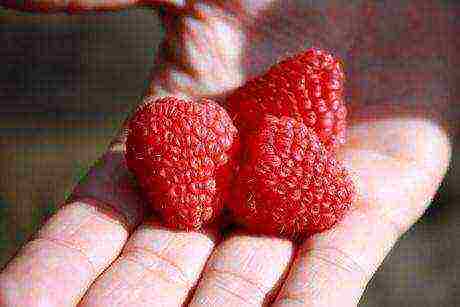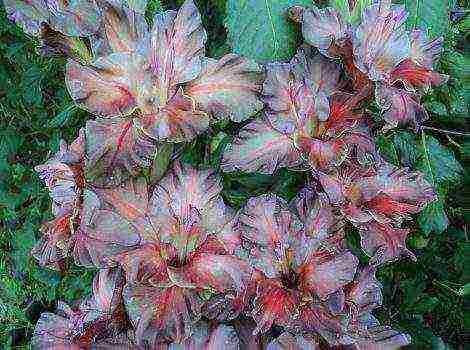Content [show]
Historically, cherry plum was considered a southern culture, because this plant is very thermophilic and is not able to withstand winter frosts. But the breeders managed to bring out new frost-resistant varieties of cherry plum, crossing it with a plum. These varieties are suitable for planting not only in the middle lane, but also in the more northern regions of Russia.
The best varieties of cherry plum for the Moscow region combine frost resistance and large-fruited plum with the taste and aroma of cherry plum.
Varieties for the Moscow region
The varieties bred for cultivation in the middle lane are distinguished by their general quality - early ripening. The crop has time to fully ripen before the onset of autumn low temperatures. There is also a common unofficial name for these varieties - "Russian plum", which unites many frost-resistant varieties of cherry plum.
Large-fruited, description
Gardeners appreciate this variety of cherry plum varieties for the size and taste of the fruit.
Tent
Photo:

A low tree, actively bears fruit already 4-5 years after planting. The branches form a dense crown that grows downward. Resistant to frost, the crop ripens early.
Cherry plum fruits are very large, up to 40 grams. To taste, the fruits are sweet and sour, suitable for fresh consumption, and for various preparations. The flesh of the fruit is dense, yellow in color.
The average yield from one cherry plum tree Tent is 35 kilograms.
The tent tolerates spring frosts well. The disadvantages of the variety are self-infertility (inability to form ovaries without the presence of pollinators) and not very persistent drought tolerance.
Huck
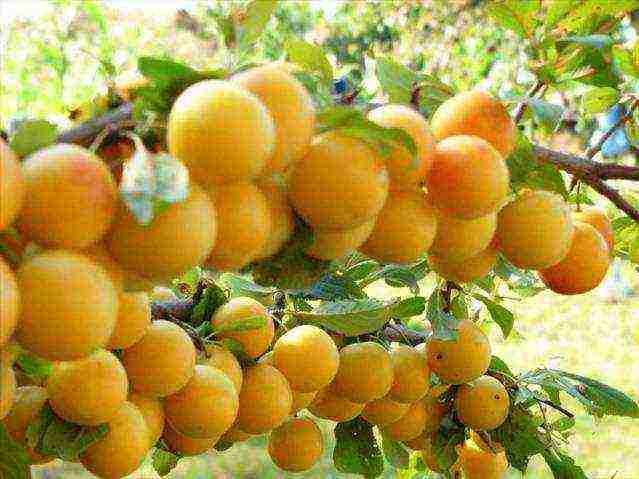
Medium-sized tree, grows very quickly, but not more than 2 meters. The harvest begins to bear 3 years after planting. The cherry plum crown is very dense and round. Huck bears fruit in medium terms (second half of July), very frost-resistant.
The fruits weigh 30-35 grams, they taste sweet and sour. Like many other large-fruited varieties, Huck is suitable for any use - both fresh and in preparations. The cherry plum pulp is dark yellow.
The yield is high (up to 40 kilograms) and stable, while the branches cope well with the weight of the fruit. The Gek variety is considered to be very adaptable to climatic conditions and soil quality. Transportable.
The disadvantages include self-infertility and susceptibility to gray rot.
Found
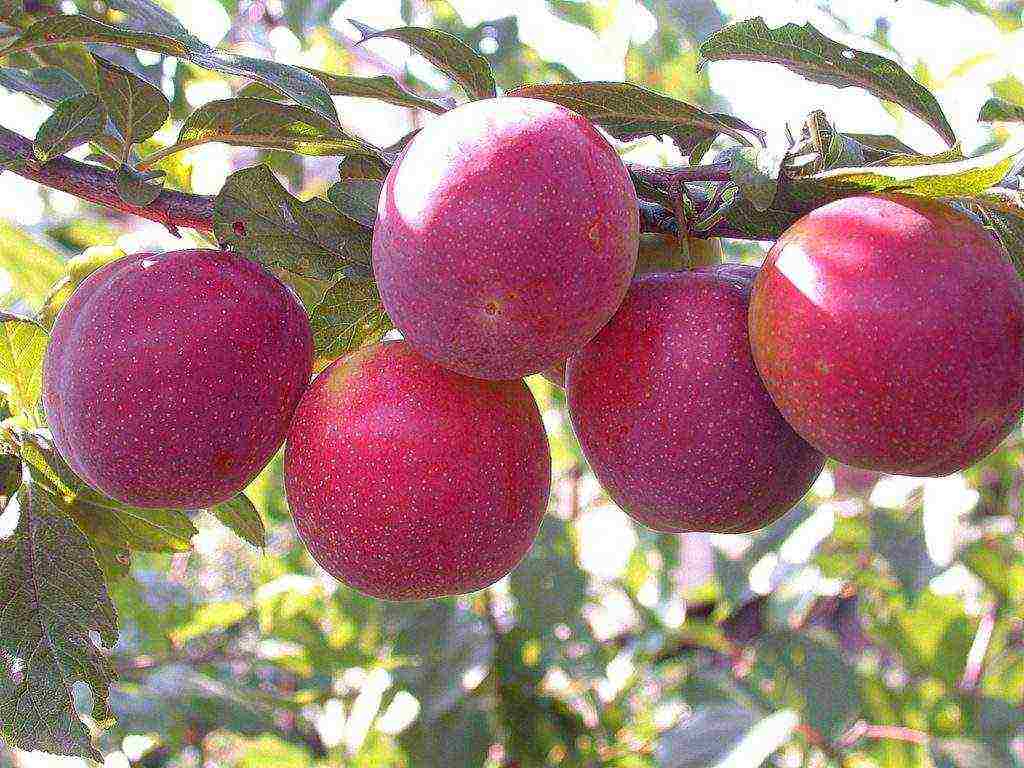
Medium ripening (second half of July). A short tree with a flat-rounded crown of medium density. Resistant to frost, brings a bountiful harvest.
The fruits are found weighing 31 grams, the flesh is rich yellow. Cherry plum taste is sweet and sour, suitable for canning and fresh food.
When overripe, the berries found do not fall for a long time, they are resistant to cracks. The average yield from one tree of this variety is 40 kilograms.
Among the disadvantages can only be called self-infertility and the difficult separation of the bone from the pulp of the fruit.
Frost resistant
The climate of the Moscow region cannot be called mild, therefore, when growing cherry plum, the resistance of the variety to frost in winter and frost in spring is very important. Among the large variety of varieties of Russian plum, several of the most winter-hardy can be distinguished.
Gift to St. Petersburg
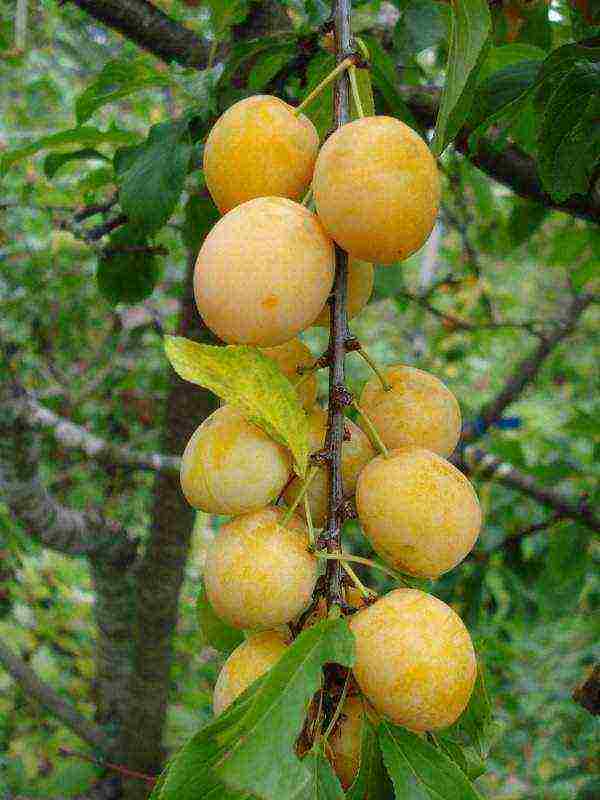
Hybrid variety, bred on the basis of the Chinese plum variety Skoroplodnaya and cherry plum varieties Pionerka. The tree is not tall, with a dense and spreading crown. Begins to bear fruit 3 years after vaccination. The ripening period for this variety is average (from the second week of August to its end).
The fruits are small, 12 grams each. The pulp is juicy, bright yellow, sweet and sour. Grade Gift to St. Petersburg is universal in use.
The yield is very high - an average of 27 kilograms, but it can bring up to 60 kilograms per tree.
Resistant not only to frost, but also to other climate fluctuations - frequent rains, etc.
Disadvantages - self-fertility and shedding of berries when ripe.
Traveler
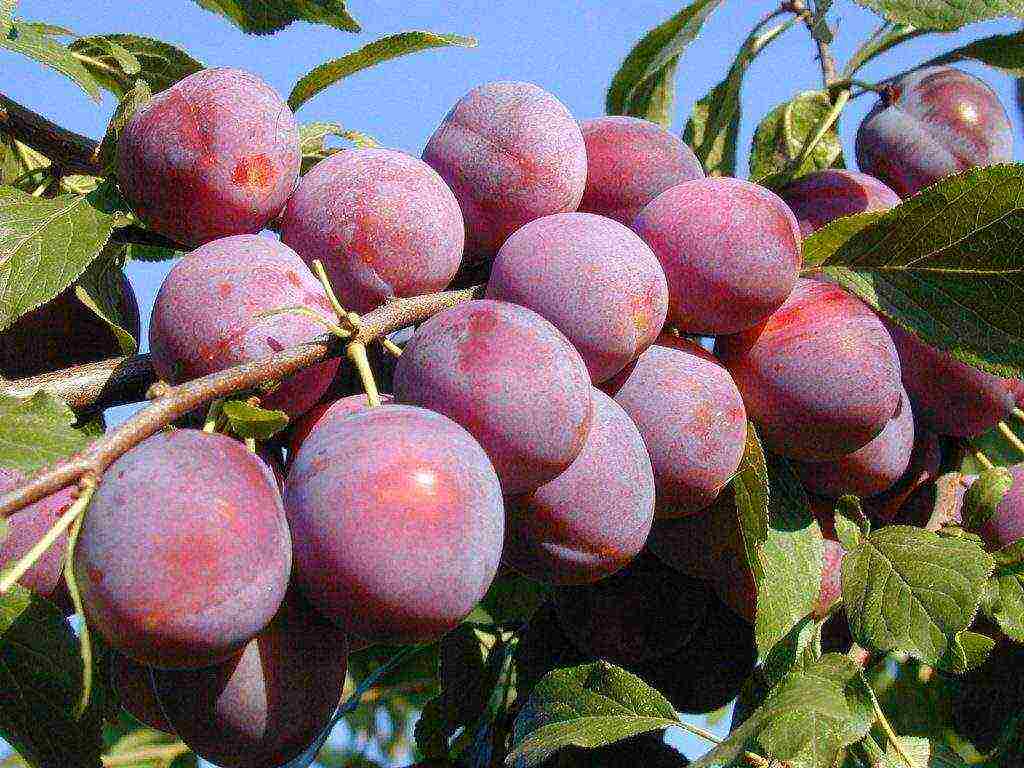
Self-pollinated hybrid variety, low, with a small crown. In addition to its high resistance to frost, it practically does not get sick with diseases common among cherry plums - moniliosis, clasterosporiosis. Begins to bear fruit at 3 years of age. The ripening period of the variety is early - early July.
The fruits of this variety are of average weight - 28 grams. The orange, juicy pulp is good for both fresh desserts and preparations.
The Traveler's yield is very high and stable - up to 40 kilograms. Can act as a pollinator for other varieties.
Disadvantages - the softness of the fruit.
Mara

Self-fertile cherry plum, resistant to cold and many diseases. The tree grows quickly, grows very tall, the crown is spreading, dense. Bears fruit for 2-3 years after planting. Ripening dates are late.
Mara fruits of average weight - 23 grams. The pulp is bright yellow, friable, very juicy. The taste is sweet and sour, versatile.
The yield is high (about 40 kilograms). Mara is considered one of the best winter-hardy varieties in almost all respects.
Popular
In addition to qualities such as frost resistance and fruit size, it is also very important to consider the ease of caring for the plant. Most often in the areas of the Moscow region these varieties are found:
Columnar
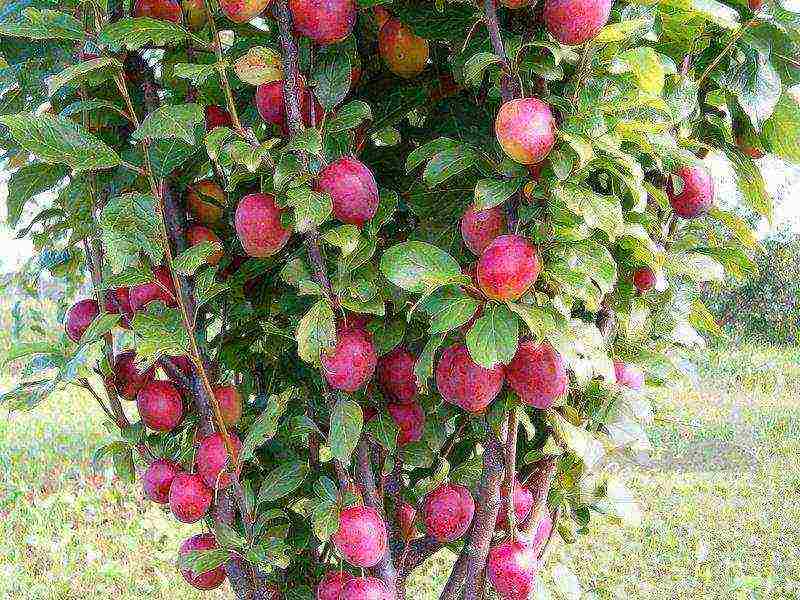
The tree is of medium height and unusual shape. The diameter of the thin crown does not exceed one and a half meters, which gives the tree a columnar appearance. This quality is reflected in the name. The variety is not only resistant to cold weather, but also has a short recovery time after freezing.
Columnar - medium late variety, ripens in early August.
The fruits are large, up to 40 grams. The pulp is pink, juicy. The taste is sweet, with a slight sourness. The variety is versatile.
The yield is high (35-38 kilograms). Columnar is cold-resistant and immune to many diseases.
Ruby
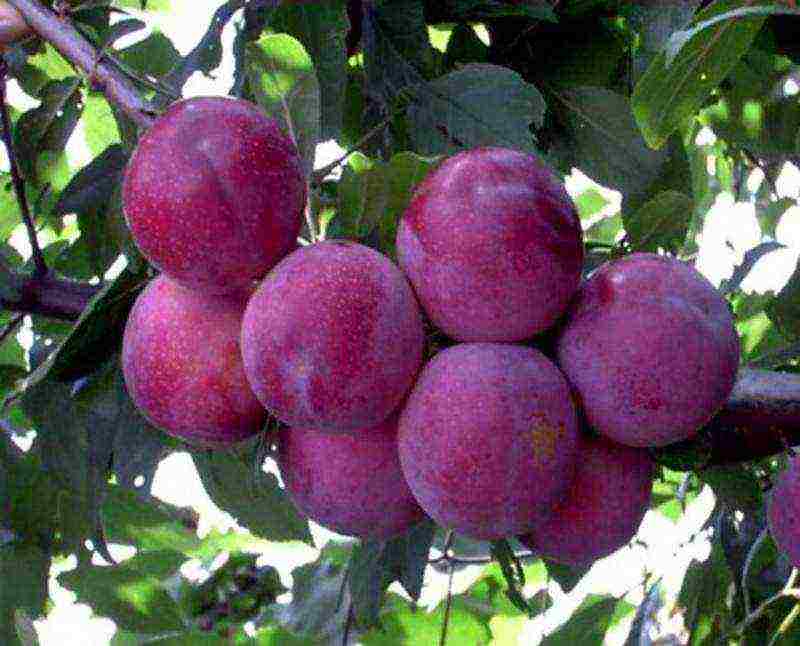
Resistant to both frost and dry growing conditions. The tree is not tall and does not require much maintenance. The crown is spreading, lush. Ripening periods are average (end of July).
Rubinova's fruits reach a weight of 35 grams, very sweet. The pulp is amber in color, with increased juiciness. This variety is especially valuable in fresh desserts.
The yield is high (up to 40 kilograms), but not stable. If during the budding period the weather was unsuitable, a good harvest may not be expected.
Gold of the Scythians

Released in 2005 and found a lot of fans. A tree of medium height, with a thin crown. Among its advantages are excellent winter hardiness and early ripening (the fruits can be tasted already in mid-June). Resistant to diseases affecting fruit trees.
The fruits are large, 36 grams. The pulp is bright yellow, very juicy, sweet and sour. The variety is versatile.
Despite the fact that the yield of Zlata Scythians is average (23-25 kilograms per tree), this variety is very much appreciated for its unpretentiousness and taste of berries.
Kuban comet
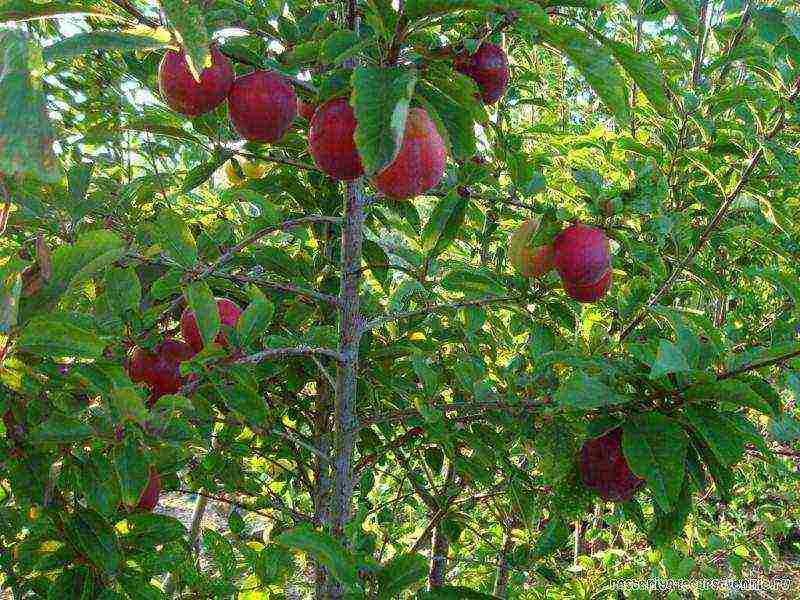
A low tree with a sparse flat-rounded crown. It is very resistant to climatic conditions, which allows it to be grown in various regions - from the Caucasus to Primorye. The variety is mid-season (early August).
The fruits of the Kuban comet are large - 28 grams. The dense yellow pulp of medium juiciness has a sweet and sour taste that is universal for use.
The yield of the variety is high - up to 40 kilograms and is stable - weather conditions have little effect on the number of fruits.
Disadvantage - cherry plum is prone to crumbling fruits with a large harvest.
Early
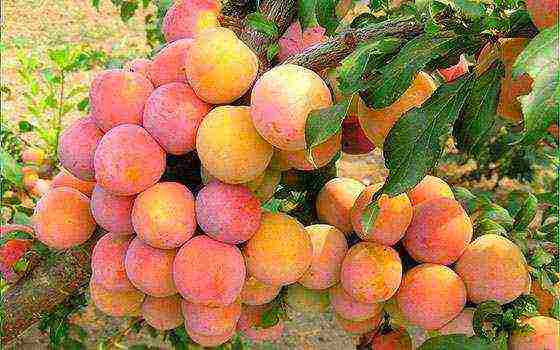
A low tree with a spreading crown of a rounded shape. Bears fruit for 2-3 years after planting. Resistant not only to cold weather, but also to strong winds. Medium ripening (early August).
Fruits of the early-growing cherry plum of medium size - up to 30 grams. The pulp is yellow, juicy, sweet with an easily separable stone. A variety of universal use.
The yield of the Fast-fruited is stable, although not very high - 30-35 kilograms.
Timiryazevskaya
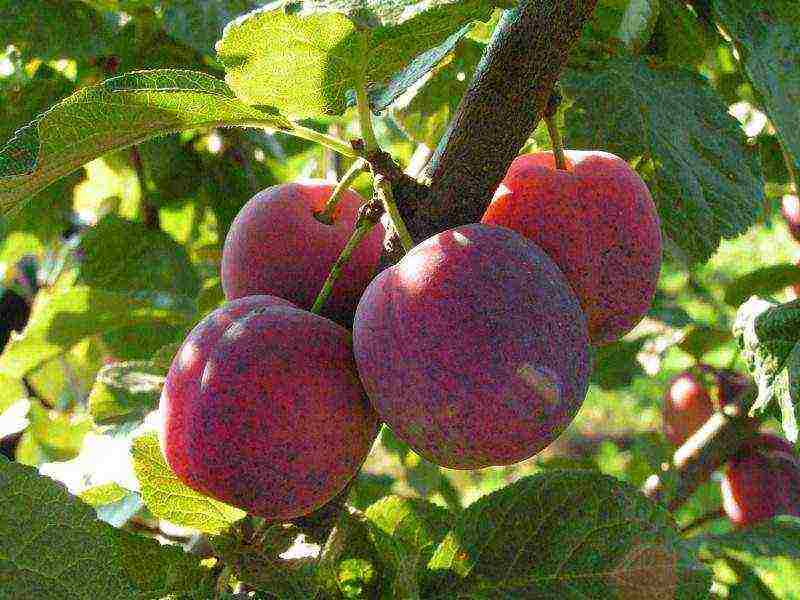
The variety was named after the scientific institute in which it was bred. A tall (3 meters) tree with a spreading cone-shaped crown. Timiryazevskaya tolerates frost well, is resistant to diseases and pests. The variety is early maturing, ripens in early July.
The fruits of Timiryazevskaya cherry plum are small (20 grams). The pulp is loose, juicy, sweet with a taste of honey. The skin of the fruit is thin, the stone is easily separated. Well suited for fresh consumption.
The yield of Timiryazevskaya - up to 30 kilograms per tree, is very stable.
A big plus of the variety is its increased winter hardiness and taste of the fruit.
Modern breeders give gardeners the opportunity to grow cherry plum not only in the southern regions of the country, but also in the Moscow region. If desired, everyone can grow this amazing culture, which does not require special care and delights the owner with delicious fruits.
Until recently, growing cherry plum in places with a changeable climate seemed just a myth, but now it is not only possible, but also necessary. The highest frost resistance is variety Seedling Rocket, and the largest fruits cherry plum Tent. Early, ready for harvesting in late July - early August: Vetraz, Monomakh, Nesmeyana. Average, maturing by the beginning - mid-August: Kuban comet, Chuk, Anastasia, Sarmatka, Karminnaya Zhukova, Aprikosovaya, Late comet, Peaches. Experienced gardeners recommend to grow in the suburbs varieties Zlato Scythians, Skoroplodnaya, Mara and Kolonovidnaya. A description of the best varieties of cherry plum or Russian plum can be found below.
The largest varieties of cherry plum, description
The taste of many fruits depends on the size of the fruit, the same goes for cherry plum. Large-fruited varieties are very popular, the best of them are considered:
Tent
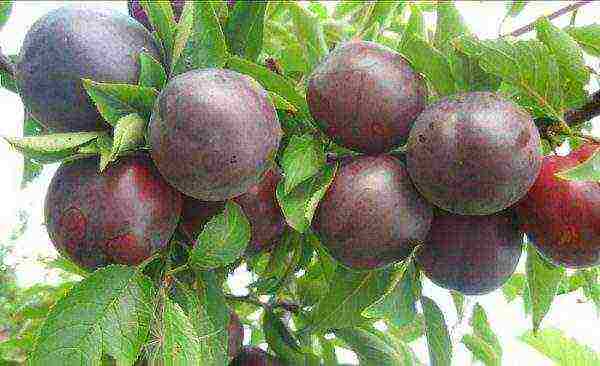 Cherry plum Tent
Cherry plum Tent
The tree is small in stature, quickly reaches the required height and begins to bear fruit for 4-5 years of life. The crown is rounded, dense, growing downward. Fruits are large in size, their weight can reach 40 grams... The pulp is sweet and sour, yellow in color, such fruits can be eaten fresh and used for preparations. The average yield of one tree is 35 kilograms.... The ripening period is early, frost resistance is high, in addition to the winter cold, the buds also tolerate spring frosts. The disadvantages include self-infertility and average resistance to lack of moisture.
Found
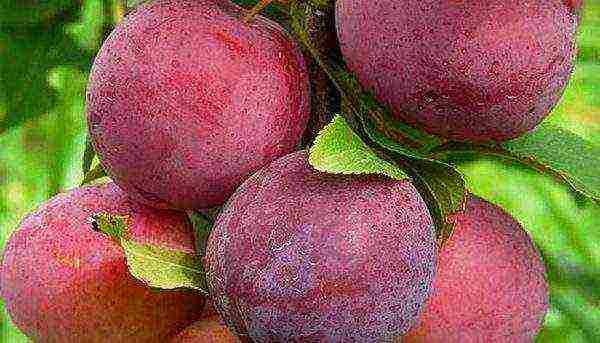 Cherry plum Found
Cherry plum Found
The variety is of medium ripening, the tree grows to medium size, the crown is dense, round, slightly flat. Fruit weight reaches 35-37 grams, the pulp is rich yellow, the taste is pleasant, refreshing, sweet and sour. A tree can bring its first harvest as early as 3 years, and after some time, up to 40 kilograms of delicious fruits can be harvested from one tree. The variety tolerates both winter and spring temperature drops, average drought resistance. Pollination occurs with the help of other varieties blooming in the same period as Naydena.
Huck
 Cherry Gek
Cherry Gek
A medium-fruiting variety. The tree grows very quickly, but at the same time reaches an average height, the crown is dense, slightly drooping, rounded. Fruits weigh up to 35 grams, the color of the pulp is dark yellow, the taste is sweet and sour, the stone is difficult to separate... The purpose of such cherry plum allows you to use it in any form. The winter hardiness of the variety is good, the same applies to the yield, which pleases with its high stability. Pollination is cross with other trees growing near cherry plum.
Monomakh
 Alycha Monomakh
Alycha Monomakh
The fruits of this variety are inferior in size to other varieties and weigh only 25-30 grams.but the distinctive feature will be excellent taste, juiciness and easy pitting. Also, this cherry plum has an unusual shape, reminiscent of a Monomakh hat and a rich, purple skin color. The harvest ripens early, the tree bears fruit annually and in large quantities.
The most frost-resistant cherry plum varieties for the central and middle lane
To grow cherry plum in Central Russia, you need to carefully consider the frost resistance of the variety. Trees should not only survive the cold winter well, but also the spring frost, because the main threat of an unstable climate lies precisely in them. The best indicators are possessed by varieties: Tsarskaya, Seanets Rocket, Vladimir comet and others.
Gift to St. Petersburg
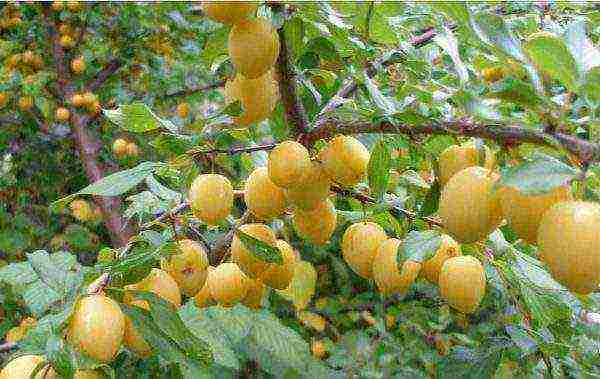 Alycha Gift to St. Petersburg
Alycha Gift to St. Petersburg
The variety has good resistance not only to cold weather, but to unstable climatic conditions, heavy rainfall and frost. A tree of medium size, with a wide, dense crown of large size, the first fruits are already at 4 years of age. The yield is annual. Fruits are light orange in color, slightly elongated in weight, reaching only 20 grams... The taste is sweet and sour, and the fruits also tolerate transportation well and can be used for various types of preservation.
Vladimir comet
 Alycha Vladimirskaya comet
Alycha Vladimirskaya comet
This variety was bred relatively recently, but already surpasses many old subspecies in all respects. A medium-sized tree has a wide, but at the same time, sparse crown. Fruits are large in size, rounded-oval in shape with a pointed end, the skin color is burgundy, there is a light waxy bloom... The pulp is a rich, dark orange shade with a sweet and sour taste. The purpose of such cherry plum is universal. The tree quickly begins to bear fruit and also quickly increases its yield; you can harvest ripe cherry plum already in mid-July. Frost resistance is very high, the same applies to the self-fertility of the variety.
Rocket Seedling
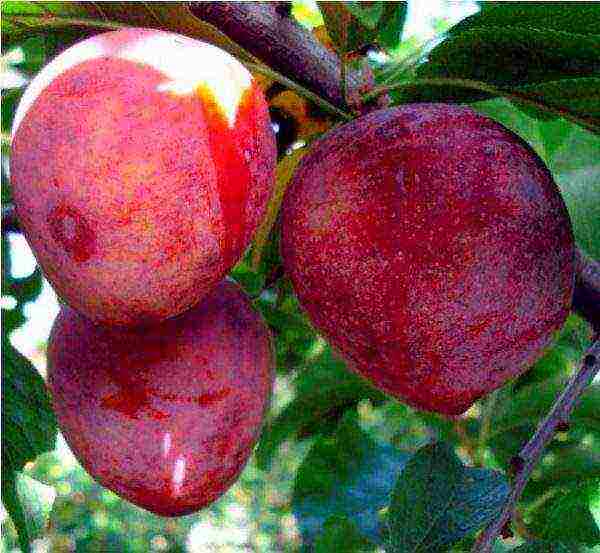 Cherry Seedling Rocket
Cherry Seedling Rocket
The variety is distinguished by exceptional frost resistance, a medium-sized tree can withstand frosts down to -35 degrees. The crown of the tree is dense, spreading. Fruits are large, grow up to 30 grams, red color, rounded shape with pointed ends... The yield of the variety is at the highest level.
Timiryazevskaya
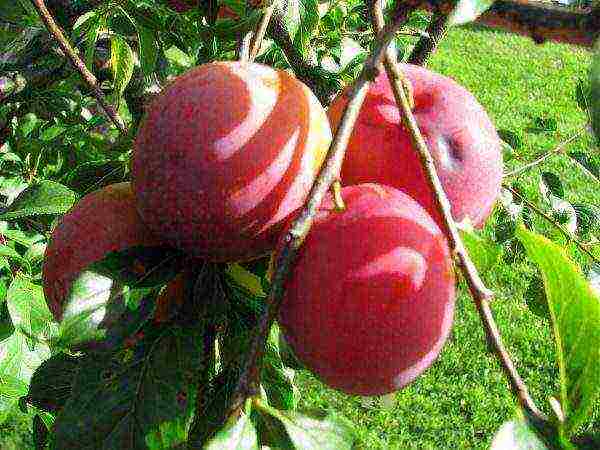 Alycha Timiryazevskaya
Alycha Timiryazevskaya
The variety got its name in honor of the scientific institute in which it was bred. The tree grows to a height of no more than 3 meters, the crown is spreading, resembles a cone in shape, foliage is very rare. The fruits are small, ovoid, covered with a thin skin of light red color.The pulp is very tasty and juicy, loose, fibrous, the stone is separated without difficulty. Up to 30 kilograms of fruit can be harvested from one tree., while it does not require complex care, tolerates frost well and is not affected by fungal diseases.
Self-fertile varieties of Russian plum
It is extremely inconvenient to grow cherry plum varieties that need additional pollination. This creates unnecessary trouble or you have to plant several varieties of the same crop in one area, which is extremely inconvenient for small farms and those gardeners who want to collect a variety of fruits. The following self-fertile varieties have proven themselves best.:
Kuban comet
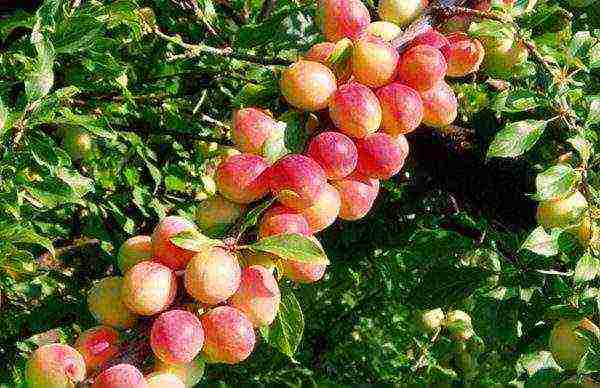 Cherry plum Kuban comet
Cherry plum Kuban comet
Perfect for growing on subsidiary plots, a tree of low growth annually brings abundant harvests of up to 40 kilograms. Fruits with a reddish, ruddy skin and yellow pulp weigh up to 28 grams, the taste is kilo-sweet, are suitable for fresh consumption and for various types of processing. The bones are very difficult to separate. The variety does not require additional pollination; both wood and flower buds tolerate frosts. The tree requires timely watering.
Traveler
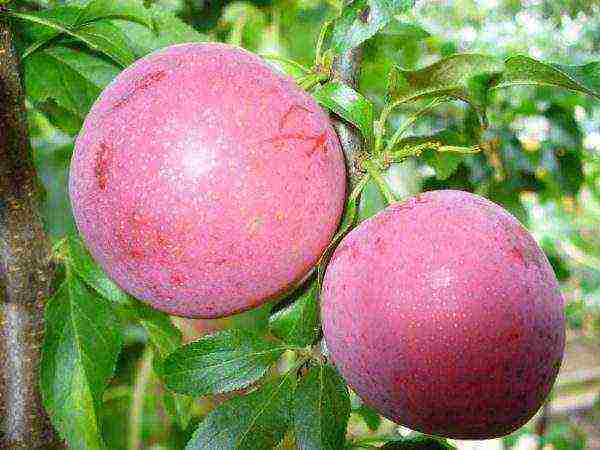 Cherry Traveler
Cherry Traveler
Acts as a pollinator for other varieties, but at the same time annually brings crops up to 40 kilograms... A tree of medium growth with an ordinary crown begins to bear fruit at 3 years of age, the ripening period is average. Traveler fruits can weigh up to 30 grams, the pulp is colored dark yellow, this variety is characterized by a light banana flavor. Frost resistance is high as well as drought resistance.
Mara
 Alycha Mara
Alycha Mara
Self-fertile variety, perfect for growing in central Russia, tolerates frost well and is immune to many diseases. A tree that grows up to 2-3 meters has a beautiful crown resembling a ball, so formative pruning must be carried out regularly. Fruits ripen in early July and can hang without dropping until early August... The skin color is intense, yellow-orange, the skin is slightly lighter. The taste is pleasant, fibrous, very sweet, this variety is perfect for cooking preserves and jams.
The best varieties for growing in summer cottages in the Moscow region
In order to grow cherry plum in the Moscow region, you need to choose the right varieties that can withstand the changeable climate, but at the same time will be easy to care for. Most often in the dachas of the Moscow region there are:
Columnar
 Cherry plum Coloniform
Cherry plum Coloniform
Perhaps the most unusual and compact cherry plum variety. The tree grows up to 3 meters in height, while the crown diameter does not exceed 1.5 meters. The variety is not afraid of frost and recovers very quickly after freezing, while other species begin to wither and slowly die. The fruits are very large, their weight can reach 40 grams, the skin of a deep red color with a light waxy bloom, is not afraid of heavy rainfall and is not prone to cracking. The pulp is tasty, juicy, fibrous.
Ruby
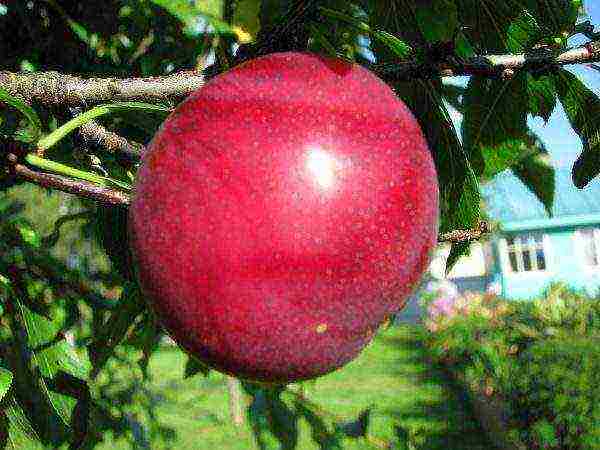 Cherry plum Rubinovaya
Cherry plum Rubinovaya
A small tree does not require complex maintenance and perfectly adapts to any weather conditions. The variety does not suffer from sudden changes in temperature and at the same time bears bright burgundy fruits with dark yellow, honey pulp. The cherry plum, ripening in the middle of summer, has no sourness in its taste, which is very attractive for lovers of sweet fruits.
Gold of the Scythians
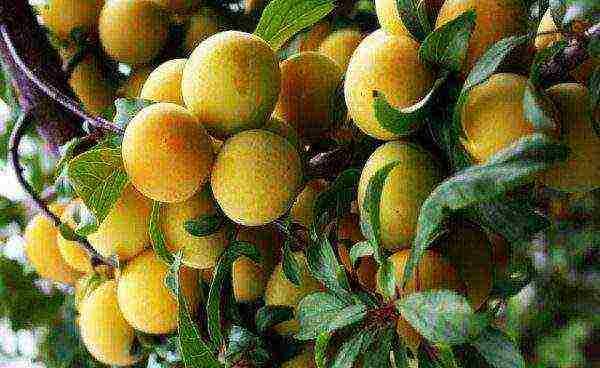 Cherry plum Gold of the Scythians
Cherry plum Gold of the Scythians
The variety was bred in 2005 and is a tree that grows to a height of no more than 3 meters with a crown shaped like a wide cone. Large fruits have a rich, golden skin color... The pulp is very sweet, juicy and tender. The tree is not afraid of a sharp change from cold to heat and vice versa, does not require long-term attention to itself, while the Scythian Gold variety bears fruit very early and annually.The size of the harvested crops is average, it needs additional pollination.
Early
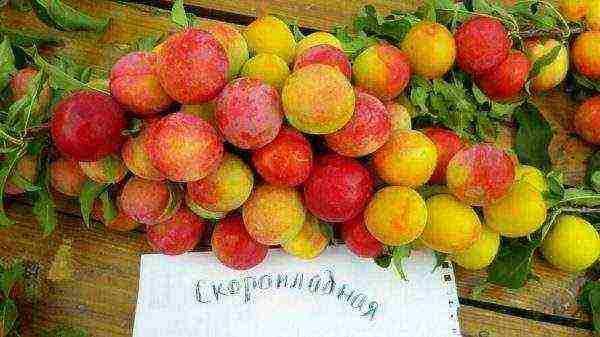 Cherry plum Skoroplodnaya
Cherry plum Skoroplodnaya
A variety of Chinese selection. The tree is small, already at 2-3 years of age, it can bring the first harvest of medium-sized reddish fruits. The pulp is very pleasant, tender and tasty, the stone is easily separated, which is why such fruits are well suited for fresh consumption. Possesses resistance to frost and gusty winds, requires planting a pollinator tree next to it.
Achievements of modern breeding allow grow cherry plum not only in the southern regions, but also in the central part of Russia... If desired, every gardener can try to grow a tree with excellent and tasty fruits on his site.
Cherry plum in natural conditions is typical for the southern regions: Crimea, North Caucasus, Central Asia. This garden culture has long been known for its juicy fruits of bright color and rich taste. Thanks to the intensive work of breeders, today varieties for growing cherry plums have also been bred in the North-West and Central regions of Russia, including in the Moscow region.
The best varieties of cherry plum for the Moscow region
Cherry plum in the diet of people is highly valued for its healthy, tasty fruits, which also have medicinal properties. And if in the south cherry plum grows without any problems, then in the Moscow region, with its unfavorable climatic conditions, it is quite difficult to grow ordinary varieties of this crop. In spring, due to cold, rainy weather, cherry plum flowers are poorly pollinated, and severe frosts in winter can damage flower buds and young shoots. In order to grow this thermophilic crop in the middle lane, it became necessary to develop zoned varieties with high winter hardiness and early ripening of fruits, as well as resistance to the main diseases of stone fruit crops. As a result of breeding work, cherry plum varieties were obtained for cultivation in the Central region, which includes the Moscow region.
Video: an overview of cherry plum varieties for the middle lane
To get rid of the negative qualities of varieties and enhance their best properties, breeders use multiple crosses between different types of plums. In the early 90s of the last century, a Russian scientist, academician G.V. Eremin, in the process of selection, bred a new variety of cherry plum, crossing the Chinese plum resistant to fungal diseases and the winter-hardy Ussuri plum with hybrids of the southern cherry plum. The new promising culture was named "Russian plum" or hybrid cherry plum. In the conditions of the Moscow region, the varieties of this cherry plum showed a fairly high winter hardiness, good quality of large, very tasty fruits and the yield is higher than that of ordinary plums.
Self-fertile varieties
Most varieties of cherry plum grown in the Moscow region are self-fertile. This means that for their high-quality pollination and fruit setting, the presence of other varieties of cherry plum or plum is necessary. However, in some species, flowers have the ability to self-pollinate, such a culture is called self-fertile. The names and characteristics of self-fertile varieties are shown in the table. In addition to these varieties, the local variety of folk selection Tulskaya and cherry plum Yayichnaya blue (selection VSTISP) are distinguished by self-fertility. It should be noted that cherry plum Morning has a high degree of self-fertility and does not require additional pollination. The Kuban comet variety is partially self-fertile and needs pollinating trees. The Vladimir comet and the Blue Dar are self-fertile varieties, but their self-fertility is rather arbitrary. If the weather is warm, dry during flowering, cherry plum flowers can be pollinated with their own pollen. This is also facilitated by the early emergence of pollinating insects: bees, bumblebees, wasps. But for guaranteed pollination and fertilization in any weather conditions, it is recommended to plant several varieties of cherry plum nearby (usually two or three varieties suitable for flowering times are enough).
Table: characteristics and main features of self-fertile varieties of cherry plum
The hybrid cherry plum can be pollinated by all types of plums, except for home plums and thorns.
Video: cherry plum variety Kuban comet
The Kuban comet, unlike many varieties of plum, perfectly adapts to various climatic conditions and is completely unpretentious to soils. It is also characterized by good resistance to moniliosis, clasterosporium disease, bacteriosis of wood. The stone, poorly separated from the pulp, is perhaps the only drawback of this variety.
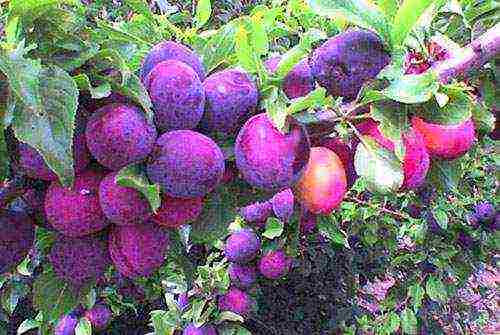 Variety Vladimirskaya comet stands out for its large fruit size and very high winter hardiness
Variety Vladimirskaya comet stands out for its large fruit size and very high winter hardiness
Alychu Vladimirskaya comet, against the general background of varieties, is especially distinguished by self-fertility, a very high degree of winter hardiness and resistance to major fungal infections. The disadvantage is the strong crumbling of the fruit after full ripening.
Cherry plum variety Columnidnaya
To improve the taste and resistance of trees to fungal diseases during breeding work, the most promising varieties of cherry plum and thorns, as well as plum and cherry hybrids, are involved in the selection. So, as a result of the use of Gayowat cherry plum, a variety of hybrid cherry plum Colonovidnaya was obtained.
The new variety was bred by the breeders of the Crimean OSS VNIIR them. N.I. Vavilov by crossing wild cherry plum and cherry plum seedling. A tree with a height of two to three meters has the shape of a column, with a crown diameter of 1–1.2 m. Rare branches extend from the trunk at an acute angle and grow along it.
At the same time, the tree trunk is mainly loaded with fruits, due to which the role of the lateral branches is insignificant. The stem has a strong, tough wood and does not bend under the weight of the crop. Cherry plum fruits are large, weighing 50–70 g, evenly distributed along the entire height of the trunk, starting from 0.5 m from the ground. Fruit color - from purple to dark burgundy, with a slight touch of pruin (fruit wax). Cherry plum taste is sweet, slightly sour. The variety is mid-late, the harvest ripens in early August.
Video: cherry plum Columnar
A variety of columnar cherry plum is the Kolonnovidnaya-2 variety. These are tall (up to six meters tall) trees of late ripening, with fruits of a dark red color with a whitish bloom. The fruits of this variety are smaller than those of the Column-shaped, the weight of each is about 35 g, the taste of the fruits is usual - sweet and sour. Unlike Columnar, the stone is easily separated from the fruit pulp.
Both varieties of columnar cherry plum are known as excellent pollinating donors for most hybrid varieties of the Chinese and Ussuri plums.
Cherry plum is characterized by its Column-shaped qualities, which distinguish it favorably in comparison with other varieties of plum:
- A high degree of winter hardiness of flower buds due to the lengthy vegetation period.
- Trees tolerate winter cold well and do not freeze at temperatures down to -28 ° C. If, nevertheless, the tree is damaged by severe frost, then it quickly recovers and continues to grow and develop normally.
- The variety is resistant to most fungal and viral diseases of stone fruit crops.
- High palatability and good transportability of the fruits make it possible to use them in a variety of ways: fresh, frozen and various kinds of processing.
- Unpretentious care and drought resistance make this variety indispensable for growing on various types of soil and in any conditions.
 Columnar fruits grow directly on the trunk, have a spectacular color and wonderful taste. A thin waxy coating on the fruits allows them to be transported without losing their presentation
Columnar fruits grow directly on the trunk, have a spectacular color and wonderful taste. A thin waxy coating on the fruits allows them to be transported without losing their presentation
Both varieties of columnar cherry plum are not self-pollinating. For their pollination, the optimal varieties are late-flowering Mara, Pchelnikovskaya, Gift to St. Petersburg.
Winter-hardy and frost-resistant varieties
The winter hardiness of the variety is one of the determining factors when growing cherry plum in the Moscow region. And you should definitely pay attention to it, tk. late frosts in spring can cause freezing of flower buds and ovaries. The best indicators of resistance to cold have varieties: Vladimirskaya comet, Gift to St. Petersburg, Ariadna, Anastasia, Nesmeyana, Cleopatra. Winter-hardy varieties of cherry plum are obtained mainly by crossing hybrid cherry plum with a related species - Chinese plum, the wood of which can withstand temperatures down to -50 ° C.
Table: main features and characteristics of frost- and winter-hardy varieties of cherry plum
Photo gallery: fruiting varieties of cherry plum with increased winter hardiness
Early varieties
As the earliest, it is possible to characterize the varieties of cherry plum Zlato of the Scythians and Timiryazevskaya. These varieties, despite a number of differences, have much in common:
- both varieties were bred at the Moscow Agricultural Academy named after V.I. K.A. Timiryazev;
- hybrids are the result of free pollination of the seedling of the Kuban comet and are recommended for cultivation in the Moscow region;
- the height of mature trees does not exceed three meters;
- both varieties of cherry plum are early maturing and have large fruits weighing from 25 to 40 g;
- regular fruiting, average yield is 25–30 kg of fruits per tree;
- trees are not capable of self-pollination and need pollinator donors; the best pollinators for these varieties are the Pavlovskaya yellow, Traveler, Gift to St. Petersburg hybrids;
- both varieties have a high degree of winter hardiness and unpretentiousness to growing conditions.
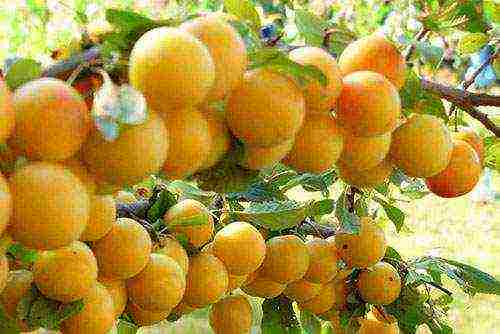 Cherry plum trees of the Scythian Zlato look very decorative during the ripening period
Cherry plum trees of the Scythian Zlato look very decorative during the ripening period
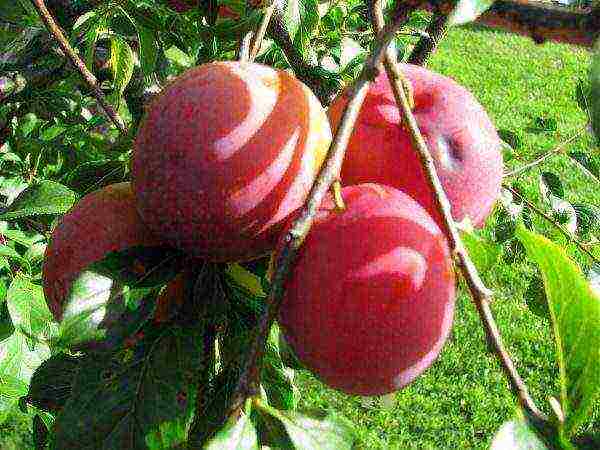 Large fruits of an unusual color are the "calling card" of the Timiryazevskaya variety
Large fruits of an unusual color are the "calling card" of the Timiryazevskaya variety
The main differences between early varieties are as follows:
- In Timiryazevskaya, the bone is poorly separated from the pulp, in the Zlata of the Scythians, it is easily separated.
- Timiryazevskaya has good resistance to the main fungal diseases, the Scythian Gold - medium.
Video: a little about the beneficial properties of cherry plum
Reviews
According to experienced gardeners, it is possible and necessary to grow a hybrid cherry plum - a Russian plum in the Moscow region. To plant a young sapling-twig and in 2-3 years to see the fruits of your labors - a cherry-plum tree, lushly blooming in spring and hung with ripe fruits in summer. One has only to try!
In the southern regions, with their mild climate, wild cherry plum grows everywhere. In the northern regions, in the middle lane, as well as in the Moscow region, under natural conditions, it cannot grow, since it is not characterized by winter hardiness. But it easily crosses with a regular plum, more resistant to frost to sudden changes in temperature and frost. In the article we will tell you about the best varieties of cherry plum for the Moscow region, we will give their detailed description.
In the Moscow region, you can grow different varieties of cherry plum
Growing cherry plum in the Moscow region
It was the plum that served as a stock for breeding hybrid forms and new varieties of thermophilic cherry plum for the Moscow region. Today cherry plum is divided into several groups, which are varieties of wild cherry plum growing in the southern climatic zone. Back in the last century, domestic breeders developed a hybrid form based on the Chinese plum, from which new winter-hardy varieties were obtained.
Now breeders have given these varieties an informal joint name - "Russian plum" - an ordinary plum with a specific sour taste. Cherry plum varieties for growing in the Moscow region have the best qualities obtained from plums - high winter hardiness and large-fruited, and directly from the cherry plum itself - an excellent taste.
The plant is easily crossed with different types of plums, which allows you to get more and more new varieties. For most of those bred for the Moscow region, they have early ripening periods. This makes it possible to harvest until the autumn frosts. Such varieties have increased winter hardiness, high productivity, resistance to diseases and pests, and are mostly self-fertile. Read also the article: → "Rules for pruning cherry plum in spring and autumn: diagram, step-by-step instructions."
★ The best hybrid varieties of cherry plum for the Moscow region
The most important criterion for growing hybrid species of cherry plum is the climate. Consider suitable varieties:
| Variety name | Characteristic |
| Kuban comet | Mid-season variety. The berries ripen in early August. They are bright yellow in color, large. The middle is fine-fiber, juicy, sweet and sour, not separating from the stone. High productivity. |
| Ruby | The variety is winter-hardy and drought-resistant variety. The harvest can be unstable due to weather conditions. Large fruits weighing 30-35 g, They have a sweet and sour taste. |
| Timiryazevskaya | An early ripe variety with high winter hardiness. Orange with a reddish tinge, small, ovoid fruits with sweet flesh with a honey flavor. The bone is easily separated from the pulp. The rind is thin. The yield is stable - up to 30 kg per tree. Resistant to fungal diseases. |
| Gold of the Scythians | The variety is early maturing. Light yellow fruits are large, juicy, sweet. Weight 40 g. Trees are spreading, up to 2 m high. |
| Cleopatra | Late-ripening variety. Resistant to frost. High-yielding. Large fruits weigh 37-40 g. Dark red. Have a purple waxy coating. The middle is red, with fine fibers, fleshy, moderately sweet. The variety is resistant to many diseases. |
| Early | An early ripe winter-hardy variety. Fruits are small, red-orange, large with yellow juicy, fragrant and sweet pulp, with a small stone, easily separating. |
| Mara | Self-pollinated winter-hardy variety, resistant to fungal diseases. Small, round, yellow fruits. Their weight is 20-23 g. The taste is sweet and sour. For 7 years of cultivation, it yields up to 40 kg of fruits from a tree. |
Harvested well in warm weather
★ Rating of the best varieties of cherry plum for the Moscow region
The following varieties can be grown in the Moscow region:
| Variety name | Characteristic |
| Nesmeyana | The mid-season variety is relatively new. The tree is tall, spreading with strong branches. Large fruits are purple-red in color. The pink center is dense, fibrous. Easily detachable bone. The taste is sweet with a slight sourness. Does not self-pollinate. The yield is average. Not resistant to disease. Transportable, stable. Used for making wines. |
| Gift to St. Petersburg | A variety of yellow cherry plum. The tree is weak, the crown looks like a weeping willow. Egg-shaped yellow-orange small fruits, sweet and sour, juicy. The bone is not separated from the pulp. Fruiting is stable and abundant. Yields up to 60 kg of harvest per tree. The variety is transportable. |
| Ruby | The fruits ripen at the end of July. They are bright burgundy with a juicy amber center. They have a fruity aroma, sweet. The variety is very winter hardy. |
| Anastasia and Huck | These varieties have very tasty and large fruits weighing 32 g. The varieties are resistant to diseases. |
| Dessert | The fruits are large. They are beautiful and delicious. With a dense skin that has a waxy coating. |
| Evgeniya | The variety is distinguished by very large fruits. They are moderately juicy, with a slight sourness. They are good fresh and for preparations. |
| Pioneer | The fruits are very beautiful and delicious. With a small bone, fragrant pulp, thin skin. |
| Pearl | The fruits are large. Their weight is 30 g. The middle is dense. A taste for an amateur. Suitable for making compotes. |
| Purple | Medium-sized orange berries, very juicy with small seeds, difficult to separate from the pulp, with a thin skin. |
| Purple dessert | The berries of this variety are very large. Their weight can reach 40 g. The pulp is bright orange, juicy. The skin is dense with a waxy coating. Ripens in mid-July. |
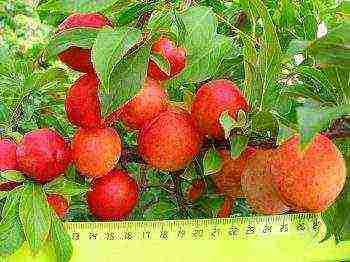
Cherry plum variety Pionerka
★ Self-fertile varieties of cherry plum for the Moscow region
We must admit right away that most of them are self-fertile only partially. They bear fruit better if trees of a different variety grow nearby. The best pollinators are varieties: Pramen, Mara, Gift to St. Petersburg. By the way, the latter blooms for two whole weeks and can pollinate both early and late varieties.
Tip # 1. Cherry plum trees of the same variety growing on the site do not give complete information about the taste and color of the berries. Therefore, you need to experiment.
Experienced gardeners recommend choosing:
- Strong seedlings of zoned varieties.
- Fast-growing varieties (they enter fruiting in two years).
- Self-fertile varieties, if others do not grow nearby.
| Variety name | Characteristic |
| Sigma | The fruits of this variety are very similar to cherries. Wide oval. They are fragrant and delicious. The color is violet-red, there is a waxy coating. The pulp is of medium density, yellow, sweet and sour. The bone is not separated from it. |
| Huck | Medium late grade. The tree is 2 m high. The crown is dense, flat-round. The fruits are yellow outside and inside, sweet and sour, large. Weight 31 g. The variety is high-yielding, winter-hardy. Transportable. |
| Kuban comet | The variety is frost-resistant. Fruits are lilac-claret, large, oblong. The pulp is of medium density, juicy, sweet. |
| Sarmatka | The variety is fast-growing. Berries are ovoid, burgundy with a light waxy coating. Beautiful, tasty, sweet and sour. The pulp is yellow, medium density. |
| Traveler | Frost-resistant early ripening variety. Berries are medium in size. They weigh 25-30 g. Bright yellow, very fragrant, juicy. The pulp is fine-fibred. The taste is sweet and sour. The bone is poorly separated from the pulp. The variety is drought-resistant. |
| Granite | Medium late grade. Winter hardy. Fruits with a waxy coating, juicy. The pulp is yellow. |
| Chuk | The variety is fast-growing. Winter hardy, high-yielding. Fruits maroon with orange pulp weigh 28 g. The middle is fragrant, dense, juicy. |
| Tent | Early ripe variety. Winter hardy. High-yielding. Weak tree. Yellowish-green with red sides, burgundy when ripe, the berries are large with a yellow dense middle. With a weak aroma, sweet and sour pleasant taste. With an inseparable bone. |
| Avalanche | Medium late grade. Winter hardy. Harvestable. The berries are large, yellow, shiny, with dark red sides. The middle is of medium density, yellow, aromatic, juicy, sweet and sour. The bone is separated freely. |
| Yarilo | Very early maturing variety. The fruits are red, shiny, large. Weight 30 g. The middle is fibrous, yellow, juicy, dense, fragrant. Sweet and sour taste. Large bone, semi-detachable. |
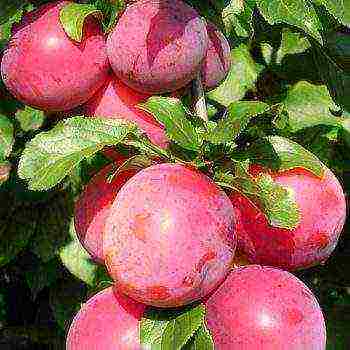
Cherry plum variety for the Moscow region called Kuban Comet
Gardeners' mistakes when growing cherry plum
Incorrect fit. Cherry plum trees will die if they are planted in deep holes filled with fertile loose soil in the lower part of the site. As a result, the plants will grow strongly and settle from their own weight, rain and melt water will stagnate in them. Then - to rot the bark at the bottom of the boles.Read also the article: → "Ways to combat clasterosporium disease on fruit trees and shrubs."
The experience of growing cherry plum in the suburbs of gardeners is still small. It has not yet experienced extreme conditions of unfavorable winters with very low temperatures, with sudden cold snaps after sharp warming.
Tip # 2. It is worth growing different crops and watching them grow and develop depending on the weather conditions.
One of the main mistakes even experienced gardeners make is the desire to buy the largest seedlings. Most often, the largest seedlings are the worst. The fact is that plants in nurseries are dug up with a plow, which leaves only half of the suction roots in a large seedling, or even less. In order for such seedlings to take root in a new place, almost all of its crown should be removed. In addition, such plants will be sick for a very long time.
And in small, ugly seedlings, the crown is not yet developed, or is absent at all, but the roots are much less damaged when excavated. Such seedlings take root much faster and in the future will outstrip much three-year-old seedlings in growth. You should not buy seedlings at spontaneous markets or from cars that call in to gardening, standing along the road. Buy seedlings exclusively zoned and only in the nursery, those that are zoned for your climate.
Another mistake is buying and planting very early seedlings that have an open root system. Seedlings of most horticultural crops are planted from September 15 to October 5-10. For cherries and plums - until September 25th.
When choosing a cherry plum variety, pay attention to all the little things of the plant.
Heading "Question-answer" about growing cherry plum
Question number 1. How can a rainy summer be reflected on cherry plum?
Due to the lack of heat, the fruits of many crops have significantly deteriorated their qualities (taste, marketable). But the prolonged rains did not affect the cherry plum in any way. Some of its fruits were even much larger than usual. With strong waterlogging of the soil, the fruits of many crops usually crack, rot and become inedible.
Cherry plum can also crack, but if such fruits are removed in time, they remain very suitable for consumption. In addition, do not forget that cherry plum is less susceptible to fungal diseases, in particular, fruit rot, but only if there is no thickening inside the crown and between plantings. Read also the article: → "How to treat the garden in autumn, and what additional measures should be taken to protect the trees?"
Question number 2. Does cherry plum need a pollinator?
According to scientific sources, some varieties of cherry plum are partially self-fertile. But it is better not to count on this partialness. You just need to plant 2-3 flowering varieties next to each other at the same time or arrange them by grafting into the crown. If you liked only one variety, or there is no room on your site, other varieties can only be grafted with one branch - its flowering will be enough to pollinate the entire tree.
Question number 3. What are the features of growing cherry plum?
Many new varieties of cherry plum are winter hardy. One of the main features of cherry plum is its rapid growth. Experienced gardeners recommend shortening strong growth shoots so that they have time to ripen. However, there are experts who dispute this method. In spring, cherry plum buds can freeze slightly. Otherwise, cherry plum is very attractive for cultivation. It starts bearing fruit 3-4 years after planting. Bears fruit annually and abundantly. The culture is relatively resistant to diseases and pests. Neutral to the close standing of waters.
Rate the quality of the article. We want to be better for you:

